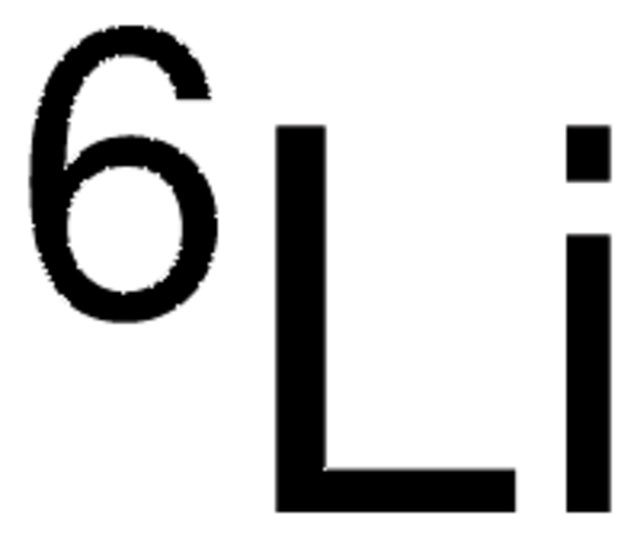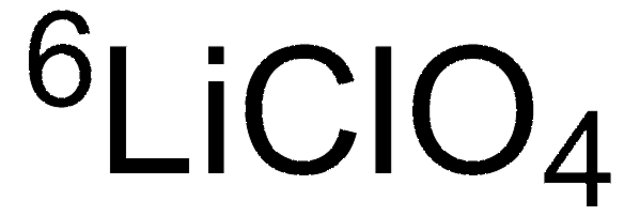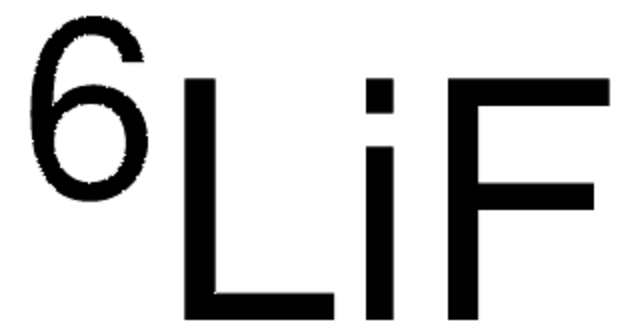601535
Lithium-7Li
≥99.8 atom % 7Li, ≥99.8% (CP)
Faça loginpara ver os preços organizacionais e de contrato
About This Item
Fórmula empírica (Notação de Hill):
7Li
Número CAS:
Peso molecular:
7.02
Código UNSPSC:
12141803
ID de substância PubChem:
Produtos recomendados
pureza isotópica
≥99.8 atom % 7Li
Ensaio
≥99.8% (CP)
Formulário
solid
alteração de massa
depleted
cadeia de caracteres SMILES
[7Li]
InChI
1S/Li
chave InChI
WHXSMMKQMYFTQS-UHFFFAOYSA-N
Categorias relacionadas
Embalagem
This product may be available from bulk stock and can be packaged on demand. For information on pricing, availability and packaging, please contact Stable Isotopes Customer Service.
Palavra indicadora
Danger
Frases de perigo
Declarações de precaução
Classificações de perigo
Skin Corr. 1B - Water-react 1
Perigos de suplementos
Código de classe de armazenamento
4.3 - Hazardous materials which set free flammable gases upon contact with water
Classe de risco de água (WGK)
WGK 1
Ponto de fulgor (°F)
Not applicable
Ponto de fulgor (°C)
Not applicable
Escolha uma das versões mais recentes:
Já possui este produto?
Encontre a documentação dos produtos que você adquiriu recentemente na biblioteca de documentos.
Mohamed Aklalouch et al.
ChemSusChem, 8(20), 3465-3471 (2015-09-19)
By comparing carbon electrodes with varying porosity in Li-O2 cells, we show that the effect of electrolyte stirring at a given current density can result in a change from 2D to 3D growth of discharged deposits. The change of morphology
Xiao Tang et al.
Scientific reports, 5, 11958-11958 (2015-07-08)
LiNi0.5Mn1.5O4 nanorods wrapped with graphene nanosheets have been prepared and investigated as high energy and high power cathode material for lithium-ion batteries. The structural characterization by X-ray diffraction, Raman spectroscopy, and Fourier transform infrared spectroscopy indicates the LiNi0.5Mn1.5O4 nanorods prepared
Emanuel Peled et al.
Nano letters, 15(6), 3907-3916 (2015-05-15)
Here, we report on the scalable synthesis and characterization of novel architecture three-dimensional (3D) high-capacity amorphous silicon nanowires (SiNWs)-based anodes with focus on studying their electrochemical degradation mechanisms. We achieved an unprecedented combination of remarkable performance characteristics, high loadings of
Birte Jache et al.
Angewandte Chemie (International ed. in English), 53(38), 10169-10173 (2014-07-25)
Although being the standard anode material in lithium-ion batteries (LIBs), graphite so far is considered to fail application in sodium-ion batteries (NIBs) because the Na-C system lacks suitable binary intercalation compounds. Here we show that this limitation can be circumvented
M Helen et al.
Scientific reports, 5, 12146-12146 (2015-07-16)
Lithium-sulphur batteries have generated tremendous research interest due to their high theoretical energy density and potential cost-effectiveness. The commercial realization of Li-S batteries is still hampered by reduced cycle life associated with the formation of electrolyte soluble higher-order polysulphide (Li2Sx
Nossa equipe de cientistas tem experiência em todas as áreas de pesquisa, incluindo Life Sciences, ciência de materiais, síntese química, cromatografia, química analítica e muitas outras.
Entre em contato com a assistência técnica









